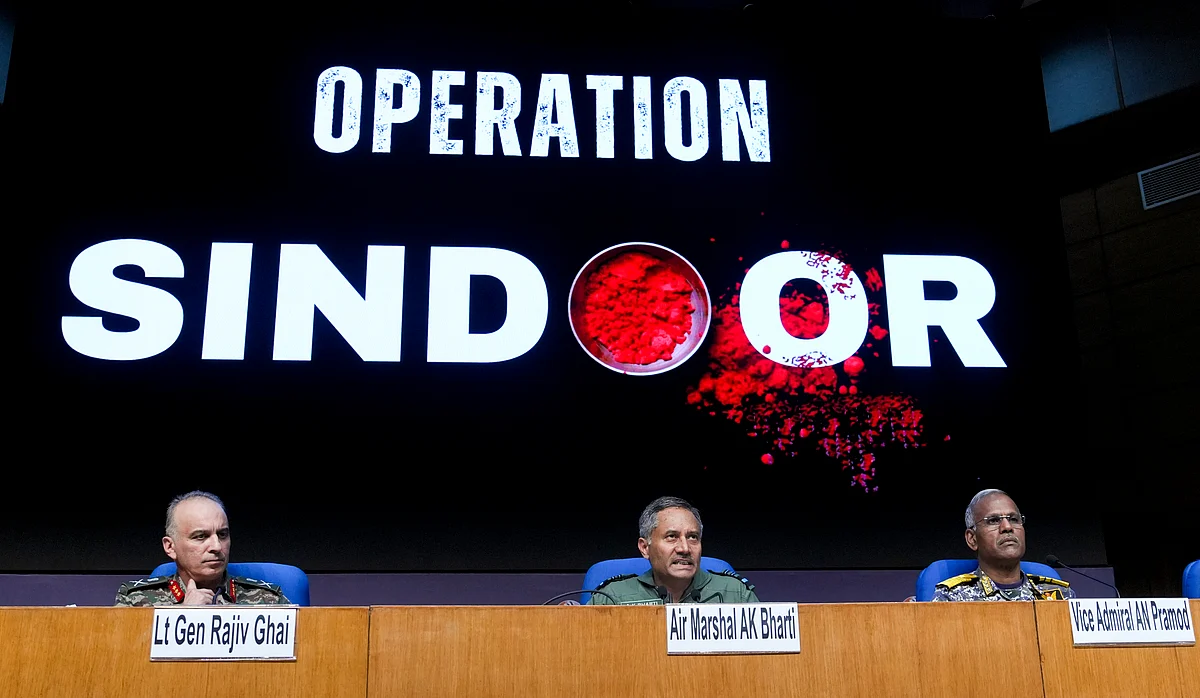'India's Air Defence Systems Shot Down Chinese Missile, Turkish Drones:' Forces
Here's what the DGs of military, air and naval operations said in today's press briefing:

advertisement
In a joint press conference by the Indian tri-services on Monday, 12 May, Director General Air Operations (DGAO) Air Marshal AK Bharti reiterated that India's fight was against terrorism and terrorists and that the Indian Armed Forces targeted only terror establishments.
"However, Pakistan chose to side with terrorists, and made it their own fight. So India was compelled to return in kind," Air Marshal Bharti said.
Director General of Military Operations (DGMO) Lieutenant General Rajiv Ghai illustrated how our multi-tier air defence successfully intercepted Pakistan's drone intrusions.
Meanwhile, Director General of Naval Operations (DGNO) Vice Admiral AN Pramod asserted that the MIG fighter jets and helicopters prevented any aircraft from closing within 100 kilometres of the carrier battle group.
Here's what the DGs of military, air and naval operations said in today's press briefing:
'India's Air Defence Systems Brought Down Chinese PL-15 Missile, Turkish Drones'
DGAO Air Marshal AK Bharti elaborated on the role of our indigenous Air Defence weapons systems such as Akash — medium range mobile surface-to-air missile system — in countering the enemy threat.
He showed footage of the remains of a Chinese PL 15 missile, struck by Pakistan but pulverised by the Indian Armed Forces. "The missile had the message 'Target'," he said.
Air Marshal Bharti also illustrates how India's air defence systems intercepted Pakistan's long-range rocket, loiter ammunitions and unmanned aerial systems.
(Image: PTI)
While pointing at the wreckage of the downed weapons and munition, he said, "You can see the JIHA system, which is of Turkish origin. You can also see some quadcopters and one odd Songar drone hanging. All these have been brought down by our trained systems."
"As far as our offensive actions are concerned, we have targeted the length and breadth of the adversary," Air Marshar Bharti said, while showing pictures of the strike on Nur Khan and Rahimyar Khan air bases. "You can see the massive crater that it has left on its runway and the pinpoint accuracy of our weapon," he added.
(Image: PTI)
He said that our air defence systems spotted the enemy drones, their fighter records, their missiles and resulted in minimal losses on our side.
'No Chance that Pakistan Could Cross Our Multi-Layer Defence'
Lt. Gen. Rajiv Ghai said that because of India's precision strikes, carried out in response to the 22 April Pahalgam terror attack, India was anticipating Pakistan's reply.
"That is why we had fully prepared our air defense in advance. In our inventory were included counter unmanned aerial systems, means of electronic warfare, and air defense weapons of the Indian Air Force. A unique integration was done with such systems," Lt. Gen. Ghaid said.
"So there was no chance that Pakistan Air Force could cross this multi-layer defense and target our assets or logistic installations behind," Lt. Gen. Ghai said.
'Should We Choose to Strike, We Can Strike at Will'
Vice Admiral AN Pramod said that effectively using multiple sensors and inputs, we are maintaining continuous surveillance to degrade or neutralise threats.
He added that a comprehensive and multi-layered air defence mechanism caters to all kinds of threats by operating as a composite force and maintaining a surveillance bubble at extended ranges using advances radars.
"Any area targets that attempts to penetrate this bubble is detected and identified using various techniques and technologies. Adequately equipped and trained to high degree of proficiency, our pilots are able to operate both by day and night," Vice Admiral Pramod said.
"Effectively, it compelled the Pakistani air elements to remain bottled up close to the markdown coast, denying any opportunity to be a threat in maritime space," he explained.
Vice Admiral Pramod reiterated that the Indian Navy maintains a credible capability "to detect identify and utilise any aerial platforms that threaten our units at sea. To sum up, the Indian Navy's dominance does ensure that should we choose to, we can strike at will."
On being asked by a reported if the Indian Armed Forces struck a purported nuclear storage facility in Kirana Hills in Pakistan, Air Marshal Bharti said, "Thank you for telling us that Kirana Hills houses some nuclear installation. We did not know about it. And we have not hit Kirana Hills, whatsoever is there."